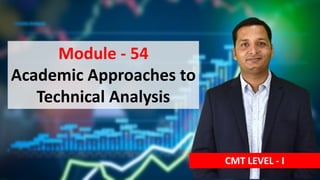
SECTION V - CHAPTER 35 - Academic Approaches to Technical Analysis
- 1. Module - 54 Academic Approaches to Technical Analysis CMT LEVEL - I
- 2. Theoretical Underpinnings • A great deal of research has been devoted ever since to formulating theoretically the efficient market hypothesis, building up market efficiency— the idea that “prices fully reflect all available information”— into one of the most important concepts in economics. • In markets where, according to Lucas (1978), all investors have “rational expectations,” prices do fully reflect all available information and marginal- utility-weighted prices follow martingales. • Market efficiency has been extended in many other directions, including the incorporation of nontrade assets such as human capital, state-dependent preferences, heterogeneous investors, asymmetric information, and transaction costs.
- 3. Theoretical Underpinnings • In Fischer Black's (1986) presidential address to the American Finance Association, he argued that financial market prices were subject to “noise,” which could temporarily create inefficiencies that would ultimately be eliminated through intelligent investors competing against each other to generate profitable trades. • Financial markets by hypothesizing two types of traders— informed and uninformed— where informed traders have private information better reflecting the true economic value of a security, and uninformed traders have no information at all, but merely trade for liquidity needs
- 4. Theoretical Underpinnings • Grossman and Stieglitz (1980) suggest that market efficiency is impossible because if markets were truly efficient, there would be no incentive for investors to gather private information and trade , provide a more detailed analysis in which certain types of uninformed traders can destabilize market prices for periods of time even in the presence of informed traders. • The evidence against the EMH and in favor of technical analysis emerged in the work of Treynor and Ferguson (1985), who show that it is not only the past prices, but the past prices plus some valuable nonpublic information, that can lead to profit. •
- 5. Empirical Evaluation • Grossman and Stieglitz (1980) suggest that market efficiency is impossible because if markets were truly efficient, there would be no incentive for investors to gather private information and trade , provide a more detailed analysis in which certain types of uninformed traders can destabilize market prices for periods of time even in the presence of informed traders. • The evidence against the EMH and in favor of technical analysis emerged in the work of Treynor and Ferguson (1985), who show that it is not only the past prices, but the past prices plus some valuable nonpublic information, that can lead to profit.
- 6. Adaptive Market Hypothesis • The adaptive market hypothesis (AMH) combines principles of the well-known and often controversial efficient market hypothesis (EMH) with behavioral finance • Andrew Lo, the theory’s founder, believes that people are mainly rational, but sometimes can overreact during periods of heightened market volatility. • AMH argues that people are motivated by their own self- interests, make mistakes, and tend to adapt and learn from them.
- 7. Adaptive Market Hypothesis • Adaptive market hypothesis (AMH) attempts to marry the theory posited by EMH that investors are rational and efficient with the argument made by behavioral economists that they are actually irrational and inefficient. • For years, EMH has been the dominant theory. It states that it is not possible to "beat the market" because companies always trade at their fair value, making it impossible to buy undervalued stocks or sell them at exaggerated prices. • Behavioral finance emerged later to challenge this notion, pointing out that investors were not always rational and stocks did not always trade at their fair value during financial bubbles, crashes, and crises.
- 8. Adaptive Market Hypothesis •Adaptive market hypothesis (AMH) considers both these conflicting views as a means of explaining investor and market behavior. It contends that rationality and irrationality coexist, applying the principles of evolution and behavior to financial interactions. •The adaptive market hypothesis (AMH) is based on the following basic tenets: - People are motivated by their own self-interests - They naturally make mistakes - They adapt and learn from these mistakes
- 9. Example of Adaptive Market Hypothesis (AMH) •During the housing bubble, people leveraged up and purchased assets, assuming that price mean reversion wasn't a possibility because it hadn't occurred recently. Eventually, the cycle turned, the bubble burst and prices fell. •One of them referred to an investor buying near the top of a bubble because he or she first developed portfolio management skills during an extended bull market.
